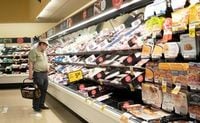Food prices are making headlines across the globe, from the Channel Islands to the United States and the Netherlands, as consumers, retailers, and regulators grapple with the complexities of rising costs, supply chain challenges, and shifting demand. On September 19, 2025, several key developments underscored just how interconnected and dynamic the world’s food markets have become.
In the Channel Islands, the head of the Channel Islands Coop, Mark Cox, warned that food prices could rise faster in Jersey than in neighboring Guernsey. The reason? Diverging ferry contracts. Jersey’s new deal with DFDS has eliminated discounts for companies importing large volumes of goods, while Guernsey’s agreement with Brittany Ferries—the parent company of Condor—has kept those discounts in place. According to BBC reporting, Cox explained, “The cost is absolutely factored into everything we do in terms of the supply chain.” He added that managing two different ferry contracts is “challenging” and contributes to the “complexity of a very expensive supply chain.”
DFDS, for its part, defends its new approach. The company has introduced what it calls a “transparent flat rate” for all customers, large and small, which it says removes the complexity of preferential discounts and ensures fairness. A DFDS spokesperson stated, “This removes the complexity of preferential discounts, ensuring fairness for smaller businesses while providing all customers with clarity and certainty over costs.” The company estimates that this new flat rate will result in a modest 0.4% increase in grocery prices—certainly not negligible, but perhaps less dramatic than some fear, especially when compared to broader logistics and distribution costs.
Still, Mark Cox acknowledged the possibility that these increased costs could be passed on to customers, saying, “We’ve ended up in a situation which is not great for either island.” Food inflation in the Channel Islands is already running above 4% and could reach as high as 5% or 6%. That’s a real headache for both retailers and shoppers. The Coop, which imports fresh food daily—including bread—has been working to offset these increases. “We’re doing our best to offset those increases,” Cox said. But it’s not just ferry contracts and inflation driving up costs. Increases to the national living wage and National Insurance payments in the UK are also affecting firms that employ large numbers of people, including food manufacturers and those in agriculture.
Despite these challenges, the Channel Islands Coop reported a “resilient” half-year performance, with turnover reaching £119 million—up 4.6% year-on-year—and a net surplus of £685,000, up £1 million from the previous year. The Coop has 123,000 members across Jersey and Guernsey and is working to pass on £2 million in savings on 800 products. Islanders recently backed the introduction of a 12-month and 24-month share class, which allows the Coop to borrow from the community instead of a bank and return the interest to local members. This, Cox hopes, will help keep prices in check and support the local economy.
Zooming out to a global perspective, food price inflation is a phenomenon not limited to the Channel Islands. In August 2025, food price inflation in the UK hit 5.1%, according to the Office for National Statistics. This uptick is starting to impact demand, although many products still represent good value for shoppers. Some consumers are tightening their belts, but others continue to prioritize fresh produce and specialty items, even as prices climb.
The United States is seeing similar trends. According to the Bureau of Labor Statistics, the August 2025 Consumer Price Index rose 0.4%—the highest since January of the same year—driven in part by a higher-than-expected increase in producer prices in July. Despite a year-over-year 2.7% increase in fruit prices, fresh produce remains a high priority for U.S. consumers. In fact, specialty and tropical fruits have seen the biggest price hikes, with mangoes and kiwis up 6.8% over the past year. Yet, sales of these fruits have surged more than 30%, and purchases are up over 7%.
Why the strong demand for pricier produce? Jonna Parker, vice president of fresh food at Circana, a market research firm, points to ample supply and growing familiarity. “There’s been lots of evidence of times where you have ample supply in produce, and it doesn’t resonate in sales,” Parker explained. “But because those flavors were already commonplace, and there was so much of it available and fresh, the American consumer got excited.” Papayas, by contrast, saw sales increase by 14%—solid growth, but only about half the rate of mangoes and kiwis. “Not all retailers carry fresh papayas, but mangoes and kiwis have become mainstream in the aisles,” Parker said. She also noted that these fruits are great for snacking, a trend that U.S. consumers are leaning into. “What works better when on the go than a piece of fruit?” she asked.
How long will this growth in sales last? Parker calls it a “serendipitous surprise” for both the kiwi and mango industries, but credits years of work to solidify these fruits’ place in American households. Despite higher prices, the American consumer’s appetite for fresh, healthy, and convenient produce appears undiminished—for now.
Meanwhile, in the Netherlands, regulators are taking a closer look at what’s driving food prices. The Netherlands Authority for Consumers and Markets (ACM) has launched a market investigation into the pricing of food products within Dutch supermarkets. This inquiry comes amid concerns that food prices in the Netherlands are significantly higher than in neighboring countries. The ACM’s investigation will scrutinize the price structures of typical grocery baskets, examine the profit margins of food suppliers and supermarkets, and compare price discrepancies with other nations. The regulator has stated it may propose recommendations to the Dutch legislature and will take enforcement action if any violations are found. Findings from this investigation are expected to be released in the summer of 2026.
The ACM’s move highlights a growing concern across Europe and beyond: Are consumers getting a fair deal at the checkout? And if not, who’s responsible—the suppliers, the supermarkets, or the broader economic environment? The answers, it seems, are as complex as the supply chains that stock the world’s grocery shelves.
From the Channel Islands’ ferry contracts to the surging sales of tropical fruit in the United States and regulatory scrutiny in the Netherlands, the story of food prices in 2025 is one of adaptation, resilience, and ongoing uncertainty. Retailers and regulators alike are wrestling with how best to balance fair pricing, supply chain costs, and consumer needs. For shoppers, the choices at the grocery store may be changing, but the search for value—and a good deal—remains as strong as ever.


